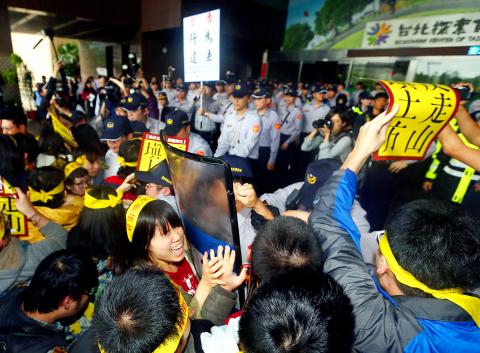Supporters of the Losheng (Happy Life) Sanatorium yesterday clashed with police, who blocked their attempt to enter Taipei City Hall after city officials refused to meet them and accept a petition calling for a halt to the construction of an MRT maintenance depot.
On Thursday the activists marched for 17km from the sanatorium to city hall and camped outside overnight to press their demands.
“Step out to take the responsibility, [Taipei Mayor] Hau Lung-bin” (郝龍斌), the angry crowd shouted as they pushed forward, trying to go into the city hall, but were pushed back by police officers holding shields.

Photo: CNA
“You have violated the Assembly and Parade Act (集會遊行法). Please back down and leave,” the police said through a loudspeaker.
No one listened, and the pushing and shoving continued, until police began dragging and arresting some of the demonstrators.
Other protesters reacted by trying to pull their companions back and yelling at the officers.

Photo: CNA
The conflict broke out just after 9am when about 100 protesters — mobilized by the Youth Alliance for Losheng and the Losheng Self-Help Organization — said they wanted to deliver a petition asking the city government to suspend the construction of an MRT maintenance depot on the site where the sanatorium is located in New Taipei City’s Sinjhuang District (新莊).
They said the construction has caused another landslide at the site recently.
City officials declined to come out and meet them.
“[The city government] has forcibly evicted Losheng residents and sacrificed the interests of the socially disadvantaged [for the MRT construction],” alliance member Lin Hsiu-peng (林秀芃) said.
“It neither cares for the lives of these people, nor the sanatorium, which is an important cultural asset,” Lin said.
With no official response forthcoming, the alliance vowed to take further action.
“As the city government has disturbed the lives of Losheng residents, we will also try to disrupt the MRT system,” Lin said.
“We would like to apologize to passengers who may be effected by our actions, but I hope that, rather than complaining, you would take some time to learn about this serious problem that has been around for 10 years,” Lin said.
Completed in the 1930s, the sanatorium was home to thousands of people with Hansen’s disease, also known as leprosy, who were kept there by force, first by the Japanese colonial government and then the Chinese Nationalist Party (KMT) regime, as the disease was thought to be highly contagious and incurable.
More than a decade ago, the government said that the sanatorium would be razed to make way for an MRT maintenance depot, triggering an opposition campaign that has compelled the government to agree to preserve a portion of the site.
However, as preservationists have long said, the construction has led to several landslides, causing several construction suspensions.
Recently, landslides have recurred, damaging some of the remaining buildings and leading the city’s Department of Rapid Transit Systems to ask the remaining residents to evacuate.

An essay competition jointly organized by a local writing society and a publisher affiliated with the Chinese Communist Party (CCP) might have contravened the Act Governing Relations Between the People of the Taiwan Area and the Mainland Area (臺灣地區與大陸地區人民關係條例), the Mainland Affairs Council (MAC) said on Thursday. “In this case, the partner organization is clearly an agency under the CCP’s Fujian Provincial Committee,” MAC Deputy Minister and spokesperson Liang Wen-chieh (梁文傑) said at a news briefing in Taipei. “It also involves bringing Taiwanese students to China with all-expenses-paid arrangements to attend award ceremonies and camps,” Liang said. Those two “characteristics” are typically sufficient

A magnitude 5.9 earthquake that struck about 33km off the coast of Hualien City was the "main shock" in a series of quakes in the area, with aftershocks expected over the next three days, the Central Weather Administration (CWA) said yesterday. Prior to the magnitude 5.9 quake shaking most of Taiwan at 6:53pm yesterday, six other earthquakes stronger than a magnitude of 4, starting with a magnitude 5.5 quake at 6:09pm, occurred in the area. CWA Seismological Center Director Wu Chien-fu (吳健富) confirmed that the quakes were all part of the same series and that the magnitude 5.5 temblor was

The brilliant blue waters, thick foliage and bucolic atmosphere on this seemingly idyllic archipelago deep in the Pacific Ocean belie the key role it now plays in a titanic geopolitical struggle. Palau is again on the front line as China, and the US and its allies prepare their forces in an intensifying contest for control over the Asia-Pacific region. The democratic nation of just 17,000 people hosts US-controlled airstrips and soon-to-be-completed radar installations that the US military describes as “critical” to monitoring vast swathes of water and airspace. It is also a key piece of the second island chain, a string of

The Central Weather Administration has issued a heat alert for southeastern Taiwan, warning of temperatures as high as 36°C today, while alerting some coastal areas of strong winds later in the day. Kaohsiung’s Neimen District (內門) and Pingtung County’s Neipu Township (內埔) are under an orange heat alert, which warns of temperatures as high as 36°C for three consecutive days, the CWA said, citing southwest winds. The heat would also extend to Tainan’s Nansi (楠西) and Yujing (玉井) districts, as well as Pingtung’s Gaoshu (高樹), Yanpu (鹽埔) and Majia (瑪家) townships, it said, forecasting highs of up to 36°C in those areas